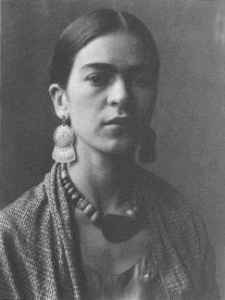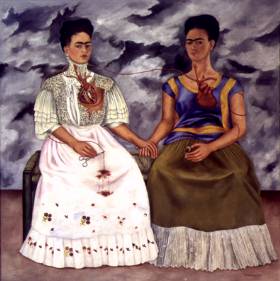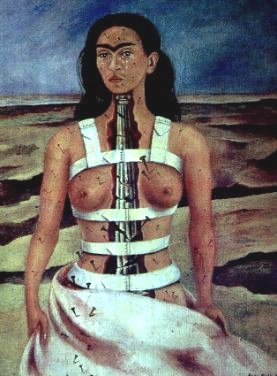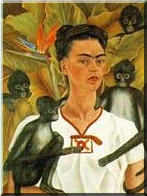Frida Kahlo
1907 - 1954 (Coyoacán, México)

Magdalena Carmen Frida Kahlo Calderón was born in the district of Coyoacán, in the outskirts of Mexico on the 6th of July 1907. She was the third daughter of Guillermo Kahlo and Matilde Calderón. In 1913·Frida suffered of a poliomyelitis attack that affected her right leg. She initiated her studies in the National Preparatory School in 1922. There she observed Diego Rivera painting his mural „La Creación“ (The Creation ). During that time, she was taking engraving classes with the teacher Fernando Fernandez.
In 1926 she had a terrible accident when travelling in a bus which was collided with a car. The result was breakage of the spine in three points, as well as collarbone, three ribs, the leg and the right foot. A tube crossed the hip to sex organs and triple fracture of pelvis prevented her from having children. That accident marked Frida Kahlo for the rest of her life, it was the spring of physical horrors and at many moments the origin of the tragedy reflected in her artistic work.

During the recuperation she began to paint her first works: the dark pictures of rigid and conventional forms. Later, already with Diego Rivera, she has perfected her pictorial technique.
She met again with Diego Rivera on the return from Russia in 1927 painting there the frescoes with the Secretariat of Education. Frida took her first pictures to him and the painter showed interest in the artist and her work; two years later they got married. Frida was 22 years and Diego was 43.
Frida and Diego then lived in Cuernavaca while the artist made the mural of the Cortés Palace. At that time she underwent the first abortion.
Later the pair went to the United States. First they stayed in San Francisco and Detroit. Finally they settled in New York. There Frida made her work “My dress hanging there”, picture that foreruns the work full of symbols that continued later. The influence of the ‚exvotos‘, the popular things, the religion and Mexican symbols had marked her work.
In 1934 Frida and Diego returned to Mexico and settled in the atelier of the AltaVista street constructed by Juan O'Gorman, in San Ángel. Frida underwent another abortion and had been operated her right foot; the process of disfigurement of her body was constant and that was reflected in the works that she were making. Diego Rivera's romance with Frida's sister, Cristina Kahlo, caused that she sunk in a tremendous depression. Then she separated from Diego and single marched to New York.
Frida Kahlo returned to Mexico to continue her work in 1937 when Leon Trotsky and his wife Natalia arrived to Mexico; Frida went single to pick them up from the Port of Tampico. They settled in her house of Coyoacán, well-known like the “Casa Azul” (Blue House). That year was one of the most prolific for Frida Kahlo, producing works like “Mi nana y yo”(My Nanny and I), “El difunto Dimas”(The Deceased Dimas), “Mis abuelos, mis padres y yo”(My grandparents, my parents and I), as well as several self-portraits. Frida's problem with the alcohol became evident.
In 1938 André Breton arrived to Mexico, with an prearranged glance to find the surrealism in this country, and finded Frida; immediately he circumscribed her as one part the essence of the surrealist movement and wrote an essay to her „a strip of silk around a pump”. This label of surrealism of the work of Frida Kahlo is one of the “mistakes” that have been continued between the massive public with respect to their classification and understanding. It is enough to mention her own words: ”… they thought I was surrealist, but I was not. I never painted my dreams, I only painted my own reality.“

In the same year Frida Kahlo made her first individual exhibition in the Julien Levy Gallery in New York. She lived a romance with photographer Nicholas Muray. The following year Frida Kahlo travelled to Paris to be present at the exhibition “Mexique” that André Breton organized with pre Hispanic works, ‚exvotos‘, photographies of Manuel Alvarez Bravo and 18 pictures of Frida Kahlo. The relations with Diego were deteriorated more and more until arriving to the divorce.
In 1940 she participated in the International Exhibition of the Surrealism in the Gallery of Mexican Art with her two works „Dos Fridas“ (Two Fridas) and “La mesa herida” (The wounded table). Her depression by the absence of Diego and her problem with the alcohol became very intense. Frida painted the “Autorretrato con pelo cortado”(Self-portrait with cut hair), work that produced in Diego the phrase “look if I had wanted you it was because of your hair…”. The 21 of August of that year, died Leon Trotsky in his house of Coyoacán. Her admiration for Trotsky had taken her to have a romance with him; the fact of suicide sunk her more in the depression. She returned to the United States to receive medical treatment. She exposed in San Francisco in the Exhibition the Golden Gate International and New York in the exhibition “Twenty Centuries of Mexican Art”. Towards end of 1940 Frida Kahlo marries with Diego again.
They returned to Mexico in 1941, and Frida did several self-portraits and had exhibitions in the Boston Institute of Contemporary Arts.
The year of 1942 marked the beginning of Frida's Diary, pages that contained diverse notes of drawing, declarations of love to Diego Rivera, phrases that remarked her solitude, her tortured body, her vision of the world, the Earth and the life. She participated in the foundation of the Seminary of Mexican Culture, and exposed in the Museum of Modern Art of New York.
Frida Kahlo exposed diverse samples in Mexico as well as in the United States and in 1943 she is named the professor of the ‚La Esmeralda‘ School of Painting and Sculpture of the Secretariat of Public Education. In that same period the paintings in the “La Rosita” pub are released in Coyoacán, made by her students of the “La Esmeralda” school, known as “Los Fridos”. In October Diego Rivera published an article about Frida entitled “Frida Kahlo and the Mexican Art” in the Bulletin of the Mexican Seminary of Culture; this article was a review of history, the society and the art of Mexico until almost arriving to Frida, declaring at the end of the exposition “… for Frida the tangible thing was the mother, the center of everything, the maternal; sea, storm, nebula, woman”.

From 1944 to 1949 Frida Kahlo participated in diverse national and international exhibitions; also she continued with her Diary and she wrote the essay “Portrait of Diego”;she drew “Diego en mi pensamiento”(Diego in my thought) and “Diego y yo”(Diego and I), works that are emblematic of Frida. She received in those years the Prize of the Secretariat of Public Education and her students decorated the walls of the public laundries of Coyoacán.
In 1950 Frida was took into the hospital for nine months due to an infection caused by the bone screwing in her spine realized four years before. There she continued with her picture “Mi fimilia” (My family) which was left unfinished. The following year she painted her “Autorretrato con el Dr. Juan Farill” (Self-portrait with the Dr Juan Farill), several dead natures, and the “Retrato de mi padre Wilhelm Kahlo” (Portrait of my father Wilhelm Kahlo).
In 1953 she carried out the top of her work by unique exhibition in Mexico in the Gallery of Contemporary Art directed by Lola Alvarez Bravo.
That same year Frida underwent the amputation of the right leg infected by gangrene. She exposed in the British Art Council.
In 1954, Frida Kahlo painted the “Sandías con leyenda: Viva la vida”(Watermelons with legend: The life lives). She entered the hospital twice more and recuperated of pneumonia. She attended a march in a protest against the coup d'etat in Guatemala. Eleven days later, the 13 of 1954 July Frida Kahlo died in her Blue House in Coyoacán.
Frida Kahlo, by the destiny, creator of her own personality, tied with her own work, performance that for all time placed her like one of the pivotal artist of the Mexican art.
Three years later, Diego Rivera died. The will of Diego was that their ashes remained in the same ballot box in their house of Coyoacán. It was opposed and their rests are in the Roundhouse of the Illustrious Men, in the Mexico City.
The most common orthographic errors of Frida Kahlo's name are: Frida Khalo, Frida Kalho, Frida Kalo and Frida Calo. Her name is frequently misspelled as Frieda.
Links - Frida Kahlo
Frida Kahlo in Wikipedia
About Frida Kahlo's Art
Frida Kahlo & Contemporary Thoughts
Frida by Kahlo - Self-portraits
Short biography of Frida Kahlo
Frida Kahlo in Artcyclopedia
Frida Kahlo - Life in pictures
 Diego Rivera
Diego Rivera